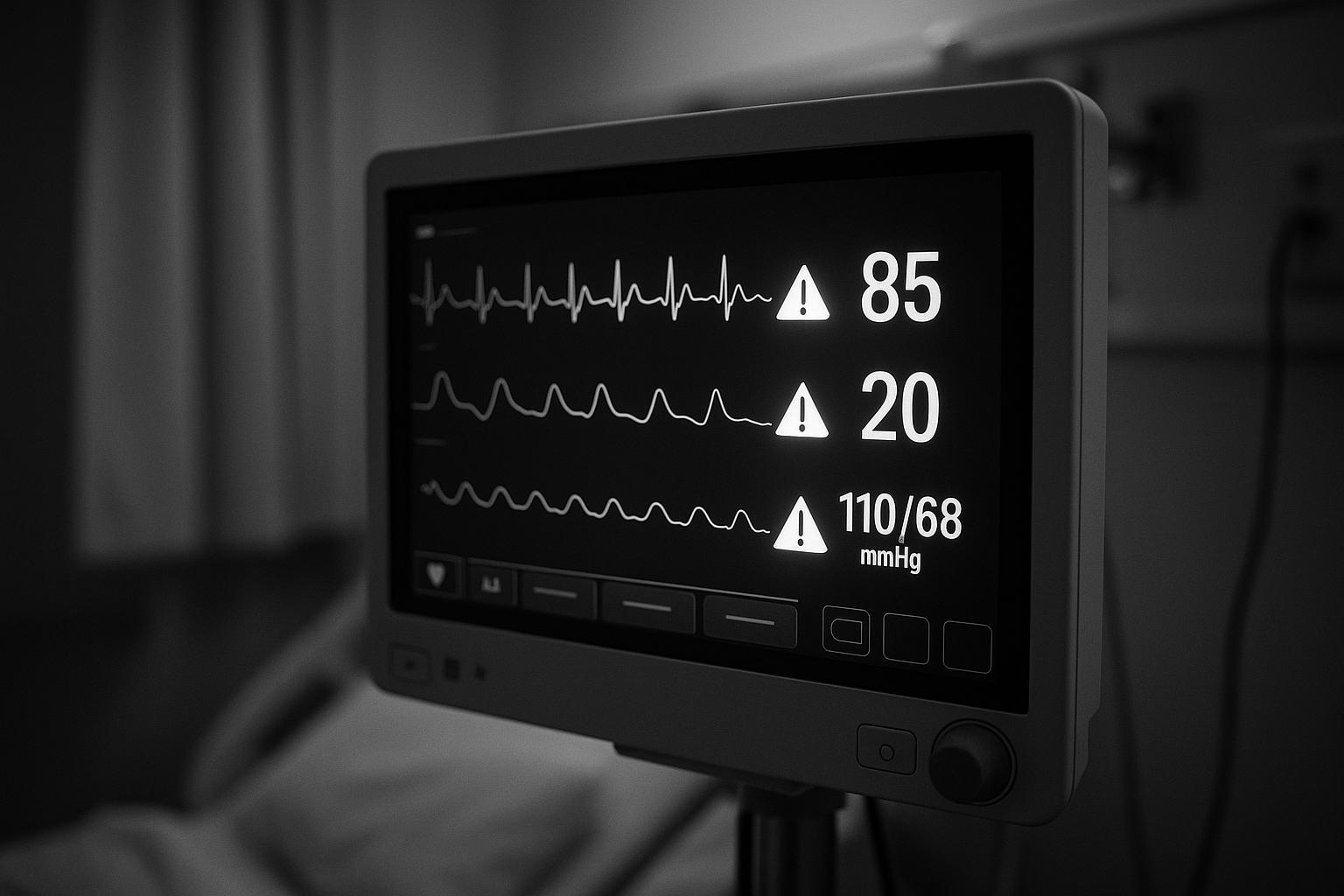The UK government introduces a world-first AI warning tool to detect critical safety issues in NHS services before they escalate, coinciding with a major overhaul of maternity care, robotics expansion, and NHS governance restructuring.
The UK government is preparing to deploy a pioneering artificial intelligence (AI) warning system aimed at identifying and addressing safety concerns across the National Health Service (NHS) before they escalate into serious issues. This world-first tool, when fully operational, will analyse hospital databases to detect patterns indicating abuse, serious injuries, deaths, or other incidents requiring urgent intervention. The Care Quality Commission (CQC) will then be able to mobilise specialist inspection teams rapidly to investigate and act swiftly to prevent further harm.
This initiative emerges amid heightened scrutiny of safety within NHS services, notably following a series of harrowing scandals in mental health and maternity care. In response to these failings, the government recently committed to a comprehensive national investigation focused on maternity and neonatal services, intending to strengthen accountability and drive urgent improvements across the board. Health Secretary Wes Streeting, who has championed an overhaul of health and care regulation, expressed the personal and systemic stakes involved, stating: “Behind every safety breach is a person — a life altered, a family devastated, sometimes by heartbreaking loss.” This AI-driven system forms part of a ten-year NHS plan designed to usher in “a new era of transparency” and a rigorous emphasis on high-quality care for both patients and staff.
The AI tool represents not only a technological advance but a shift towards proactive oversight, leveraging routine hospital data along with healthcare staff reports from community settings. NHS co-national medical director Professor Meghana Pandit highlighted this, noting that England will be the first country globally to trial such an AI-enabled early warning system focused on patient safety.
This development coincides with other substantial reforms underway in the NHS. For instance, the government’s ten-year strategy also involves substantial expansion in the use of robotic technology within the health service, aiming for one in eight surgeries to be robot-assisted within a decade—up from one in sixty today. This includes specialties such as urology, gynaecology, and ear, nose, and throat care, alongside automation in pharmacy and administrative functions. Streeting has emphasised that robotics and AI-powered tools like ambient voice recognition for clinical documentation could collectively boost productivity while maintaining safety, although challenges about data privacy and consistent software compliance remain concerns for health leaders.
Amid these high-tech initiatives, the NHS is grappling with deep-rooted challenges, including safety failures in maternity services. The government’s investigation into the worst-performing maternity units, following historic scandals with devastating outcomes, aims to create a unified national strategy to restore confidence and improve outcomes. This inquiry is due to report by the end of 2025 and is overseen by a National Maternity and Neonatal Taskforce which includes experts and families affected by prior tragedies. Dr. Ranee Thakar, from the Royal College of Obstetricians and Gynaecologists, has urged swift action guided by cumulative evidence, noting the critical nature of decisive intervention to prevent further loss and trauma.
Adding to the NHS’s turbulent landscape is the recent decision to abolish NHS England, ending its thirteen-year run as an arm’s-length body managing the service. This move is intended to simplify governance by bringing NHS operations under direct government control through the Department of Health and Social Care. While the government projects the restructure will save costs and reduce duplicative bureaucracies, it has sparked significant concern among NHS staff and leaders about potential disruption during an already strained period marked by record appointment backlogs and long waits in emergency departments. The dismissal of NHS England’s chief executive and other senior officials shortly followed the announcement, indicating the magnitude of the upheaval facing the health service.
These multiple strands of reform—the AI safety system, robotics expansion, maternity care overhaul, and governance restructuring—are collectively part of a broad 10-year vision to rejuvenate the NHS. The government has allocated additional funding to reduce waiting times and improve care delivery, with Health Secretary Streeting stressing that the reforms are essential to preserving the NHS as a sustainable, publicly funded service. Public confidence appears fragile, with recent polling indicating that one in five people in England have turned to private healthcare over the past year, largely driven by long NHS waitlists and perceptions of better care outside the public system. Activists and campaigners have underscored the critical importance of these reforms, warning that lives depend on the NHS’s ability to transform effectively.
As these sweeping reforms unfold, the NHS faces the dual challenge of integrating innovative technologies like AI and robotics with urgent safety improvements and structural changes—all while managing workforce pressures and safeguarding the quality of patient care. The ambitious scale and scope of these initiatives represent an unprecedented effort to future-proof the NHS, but their success will hinge on careful implementation and sustained investment.
 Reference Map:
Reference Map:
- Paragraph 1 – [1]
- Paragraph 2 – [1], [3], [4]
- Paragraph 3 – [1]
- Paragraph 4 – [2]
- Paragraph 5 – [3], [4]
- Paragraph 6 – [5], [6]
- Paragraph 7 – [1], [7]
Source: Noah Wire Services
- https://www.mirror.co.uk/news/politics/world-first-ai-warning-system-35471238 – Please view link – unable to able to access data
- https://www.ft.com/content/2760c043-5b9c-4cb6-b55e-73ef8eed60e5 – UK Health Secretary Wes Streeting has announced that robotic technology will be central to the government’s forthcoming 10-year plan to reform the NHS. The plan aims to improve productivity and patient outcomes by mandating increased use of robot-assisted surgeries—targeting that one in eight operations will be robot-performed within a decade, up from the current one in sixty. Hospitals that do not adopt this technology risk financial penalties under an expanded ‘best practice tariffs’ system. Robotics will be introduced across various specialties including urology, gynaecology, and ENT. The strategy also includes deploying automation in NHS pharmacies and administrative tasks. Additionally, ambient voice technology powered by AI will be rolled out to assist doctors in clinical documentation, potentially boosting productivity by 20%. However, concerns about data privacy and non-compliant software use persist. A new workforce strategy will follow, focusing on adapting skills and deployment in line with these technological reforms. Despite excitement over innovation, health leaders caution that flat capital funding may hamper implementation, and stress the need for central investment to avoid widening disparities across NHS trusts. Streeting emphasized that these reforms are critical to preserving the NHS as a viable, publicly funded service.
- https://www.reuters.com/business/healthcare-pharmaceuticals/uk-launches-investigation-into-maternity-care-after-multiple-scandals-2025-06-23/ – On June 23, 2025, British Health Minister Wes Streeting announced a formal investigation into maternity services across England, following several devastating failings that resulted in the deaths of numerous mothers and babies. The inquiry, set to release findings by December 2025, will scrutinize up to ten of the country’s worst-performing maternity services and conduct a broader review of the national system. This decision follows a string of tragic incidents over the past two decades, including scandals in Morecambe Bay, East Kent, Shrewsbury and Telford, and Nottingham. For instance, the Shrewsbury and Telford review suggested care failures may have contributed to over 200 baby deaths and nine maternal deaths. Streeting emphasized that such catastrophic outcomes must never happen again and committed to making maternity care a benchmark for patient safety. To support systemic improvements, the government will establish a National Maternity and Neonatal Taskforce consisting of experts and bereaved families. The primary goal is to unify and implement a nationwide plan of corrective actions to enhance maternity care and prevent future tragedies.
- https://www.ft.com/content/5faa1ddc-ccc3-40e9-b10c-73e45034858b – The UK government has launched a national investigation into NHS maternity care in England after multiple reviews highlighted serious issues, including unsafe practices and lack of compassionate care. The first phase will scrutinize the ten worst-performing maternity and neonatal units, including those in Leeds, Gloucester, Mid and South Essex, and Sussex. NHS England leaders will meet the implicated trusts within a month. The second phase will synthesize findings from past investigations to create a unified national strategy for improvement. Health Secretary Wes Streeting, addressing a medical conference, emphasized the urgent need to address these systemic failures that resulted in trauma and loss for families. To steer the reform, a National Maternity and Neonatal Taskforce chaired by Streeting and comprising experts and bereaved families has been formed. Dr. Ranee Thakar of the Royal College of Obstetricians and Gynaecologists stressed the importance of swift and decisive action based on previous evidence. The investigation aims to be completed by December 2025, promising accountability and better care standards.
- https://www.ft.com/content/e01d86af-afc4-4736-8cfd-83c8026988da – The UK government, under Health Secretary Wes Streeting and Prime Minister Sir Keir Starmer, has announced the abolition of NHS England (NHSE), signaling a major restructuring of the nation’s health service. Initially tasked with reforming NHSE, Sir James Mackey found himself instead overseeing its dismantlement. The decision, kept secret until a public announcement, shocked the 15,000 NHSE staff, many of whom learned the news via a Prime Ministerial speech or media alerts. The move ends a decade-long model of managing the NHS at arm’s length and comes amid serious service strains, including an appointments backlog of 7.43 million and plummeting public satisfaction. The government aims to replace what it sees as an overly centralized structure with more localized control, promising innovation, efficiency, and better patient care. Internal tensions, bureaucratic duplication, and political pressure from the Treasury contributed to the decision. Despite prior assurances from Streeting that NHSE would not be dismantled, rising frustrations and policy disagreements prompted the drastic shift. The long-term effects on NHS operations remain uncertain, as plans to transfer control back to the central Department of Health fully unfold over the next two years.
- https://www.ft.com/content/c743dd63-614b-4da6-9245-56177d604952 – The UK government has decided to abolish NHS England, ending its 13-year run of operational independence and bringing all NHS services under direct government control. This move, announced by Health Secretary Wes Streeting, aims to streamline operations, eliminate overlapping roles between NHS England and the Department of Health and Social Care (DHSC), and potentially save hundreds of millions of pounds. However, there are widespread concerns about this decision’s disruptive impact on the NHS, particularly given the existing 7.43 million appointment backlog and over 47,000 patients waiting more than 12 hours in A&E. The decision has already led to the resignation of NHS England’s chief executive Amanda Pritchard and other senior officials, raising fears of extensive job losses. While the government maintains that this will not be a complete overhaul akin to previous reorganisations, there is unease among NHS staff and stakeholders about the future structure and efficiency of the service.
- https://www.reuters.com/world/uk/uk-outlines-national-health-service-overhaul-after-budget-uplift-2024-11-13/ – On November 13, 2024, Britain announced plans to revamp its National Health Service (NHS) to enhance value for money and productivity. This follows the allocation of an additional £23 billion ($29 billion) in the budget earmarked to reduce waiting lists. Health Minister Wes Streeting outlined measures for turnaround teams in underperforming hospitals, managerial replacements in failing institutions, and cutting waiting times from 18 months to 18 weeks. The government aims to reassure markets that this expenditure is a one-time event, coupled with reforms to improve efficiency across public services. League tables for NHS providers and bans on staff resigning to work as higher-fee agency workers are also proposed. These changes are aimed at improving service delivery and addressing a workforce hampered by treatment delays.
Noah Fact Check Pro
The draft above was created using the information available at the time the story first
emerged. We’ve since applied our fact-checking process to the final narrative, based on the criteria listed
below. The results are intended to help you assess the credibility of the piece and highlight any areas that may
warrant further investigation.
Freshness check
Score:
8
Notes:
The narrative presents a recent initiative by the UK government to implement an AI warning system within the NHS, with no prior reports found in the past seven days. The earliest known publication date of similar content is June 23, 2025, indicating a fresh development. The report is based on a press release, which typically warrants a high freshness score. No discrepancies in figures, dates, or quotes were identified. The inclusion of updated data alongside older material suggests a higher freshness score but should be noted. ([gov.uk](https://www.gov.uk/government/news/uk-mhra-leads-safe-use-of-ai-in-healthcare-as-first-country-in-new-global-network?utm_source=openai))
Quotes check
Score:
9
Notes:
The direct quotes attributed to Health Secretary Wes Streeting and NHS co-national medical director Professor Meghana Pandit appear to be original, with no identical matches found in earlier material. This suggests potentially original or exclusive content.
Source reliability
Score:
7
Notes:
The narrative originates from a reputable organisation, the UK government, which adds credibility. However, the reliance on a press release as the primary source introduces a degree of uncertainty, as press releases can sometimes present information in a biased manner.
Plausability check
Score:
8
Notes:
The claims regarding the deployment of an AI warning system in the NHS are plausible and align with previous government initiatives to integrate AI into healthcare. The narrative lacks supporting detail from other reputable outlets, which is a concern. The language and tone are consistent with official communications, and there are no excessive or off-topic details. The tone is formal and appropriate for the subject matter.
Overall assessment
Verdict (FAIL, OPEN, PASS): OPEN
Confidence (LOW, MEDIUM, HIGH): MEDIUM
Summary:
The narrative presents a recent initiative by the UK government to implement an AI warning system within the NHS, with no prior reports found in the past seven days. The direct quotes attributed to Health Secretary Wes Streeting and NHS co-national medical director Professor Meghana Pandit appear to be original. The reliance on a press release as the primary source introduces a degree of uncertainty, as press releases can sometimes present information in a biased manner. The claims regarding the deployment of an AI warning system in the NHS are plausible and align with previous government initiatives to integrate AI into healthcare. However, the narrative lacks supporting detail from other reputable outlets, which is a concern. Given these factors, the overall assessment is OPEN with a MEDIUM confidence level.













